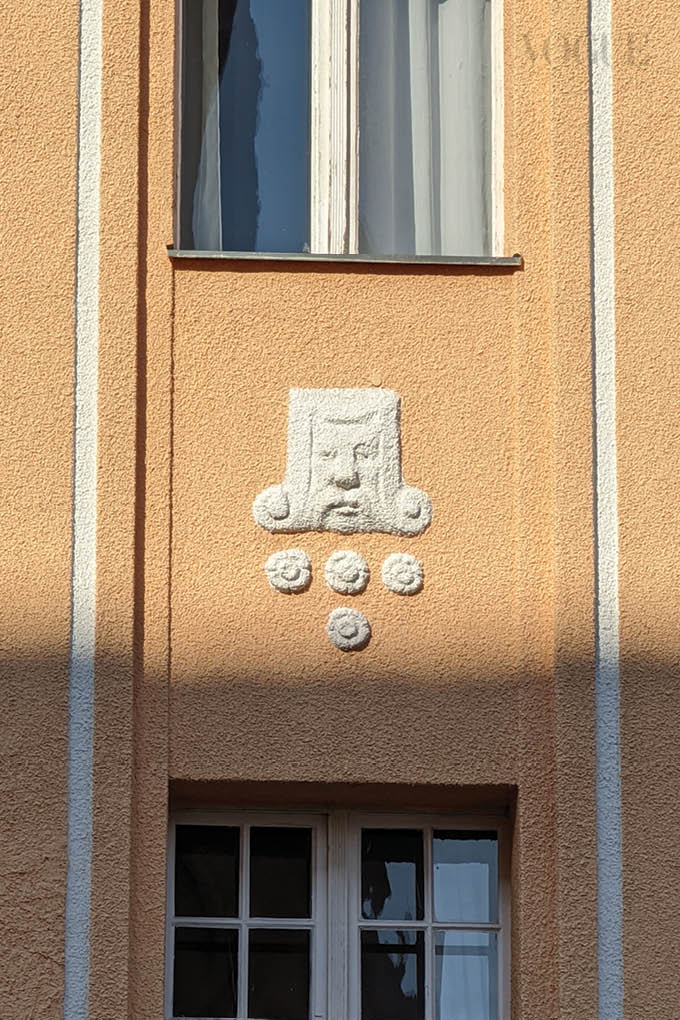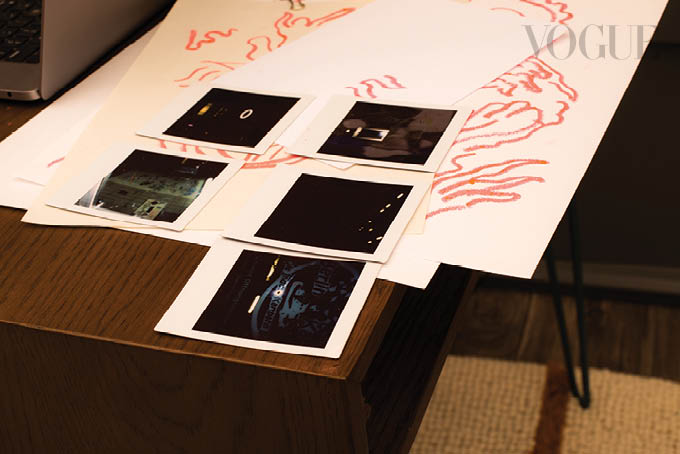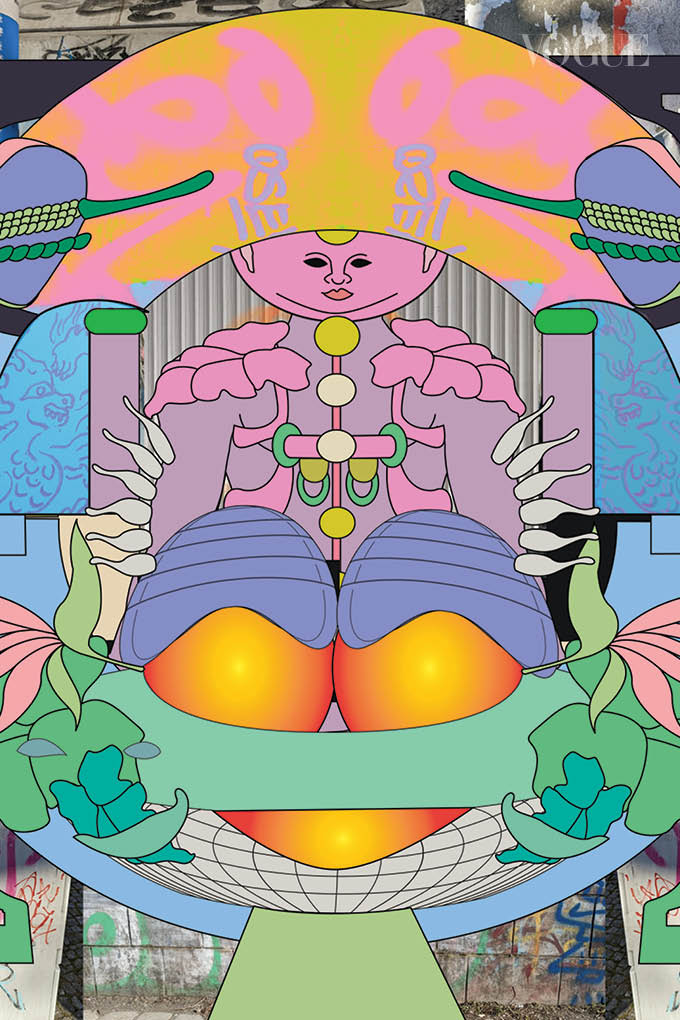Vogue artist-in-residence Reza Hasni spreads positivity through ‘Eostre’
7 April 2022
Motion graphics artist Reza Hasni interprets the theme of Vogue Singapore’s April issue—Rapture—by taking his audience through the magic of spring and the spirit of positivity it evokes in our hearts
Creating art for Berlin-based Singaporean artist Reza Hasni is like going on a journey—“a contemporary reflection of our world and its unseen energies”, all of which collide yet tell a lucid story as a digital collage. A mix of mystic shapes, cryptic messages, and real and surreal experiences, Hasni’s work is as immersive as it gets and urges his audience to search beyond their existing realities. The ability to do that is what drew Hasni, who started his career as a graphic artist for print, to the world of motion graphics—for his audience to be able to partake in the different scenes and visual stimulations in his head.
To that end, his canvas (or computer screen) is the last step in the process, as Hasni steps out into the real world for inspiration, his polaroid camera on hand and takes snapshots of the things that stir an emotion in him.



No stranger to the Singapore art scene, Hasni was an active participant in Singapore’s art scene—drawing, painting and participating in exhibitions local and international. His portfolio spans artworks created for exhibitions and high-profile events including F1 Grand Prix Singapore, Singapore Art Week 2022—Hasni’s work was part of the multimedia experience Happy House presented by Mama Magnet and Council—and Light to Night Festival, to his foray into the nightlife scene through animated artworks for Zouk Singapore and 宀 (Mihn) Club in Hong Kong. He has also participated in international events such as Summerwell Festival Romania and works with some top brands and media giants including BBC and CNBC International.
One thing that stands out in all his work: his aim “to spread positivity through imagery”—which is not hard to believe as there’s an aura of unmistakable zen about Hasni’s demeanour. A similar fervour surrounds Eostre, the work he created for Vogue Singapore’s April issue—the theme of which was ‘rapture’.
Hasni interprets the idea of ‘rapture’ through the comparable elation that the season of spring brings, hoping to conjure a similar reality for his audience. Eostre is inspired by the magic and energy of spring. “Whether audiences interact with it hypnotically, aesthetically or in a contemplative manner, my works are spaces built for accommodating interpretation,” says Hasni.
Here, we chat with the artist to gain insight on his career trajectory, design and thought process, and Eostre.
Tell us about your journey into motion graphics. What inspired you to adapt this particular art form?
When I was in the graphic design industry, I had been actively drawing, painting and participating in art exhibitions. But I felt my drawings needed more input of motion than they were implying.

There is a lot of movement happening in my head when I draw and create different scenes or visual simulations. I began wondering how I could bring audiences on that journey with me. So I started experimenting with animation on my own—that’s when I joined Zouk under their old management at Jiak Kim St under Lincoln Cheng. I was handling their online and offline video promos, which allowed me to play around with motion graphics. I had a lot of ideas at that time and the local clients weren’t ready for that so I decided to go on my own as an artist.
How have you evolved as an artist?
Over a period of time, I found myself having to unlearn a lot of my thinking and started experimenting and building my own voice in animation. And this is where I am at now. I am still learning and unlearning, experimenting, building new ideas and deconstructing them. Working with moving images and time-based art also enables me to incorporate sound design to better communicate with my audience about these visual and audio journeys.
How has Berlin influenced your art and you as an artist?
Berlin brought about changes in many ways. It taught me to unlearn what I knew and was attached to, in order to rebuild it in a new environment and see things with a different perspective. Change is a sign of growth, it’s never a bad thing. Creatively and personally, this has been healing.
Music is an important aspect in my work. Being in Berlin, which is the birthplace of cutting edge music, I’ve gotten to meet and collaborate with DJs and performers on live and recorded audio-visual projects. It’s truly been like a dream come true.
Tell us about your design process.
My works are a contemporary reflection of our world and its unseen energies. I use my art as another mode of thought, a way to express the stories stirred up in my imagination. My work can be seen as a visual representation of an alternate world or a way to escape from the limitations of our reality.

My process involves deconstruction of my memories and dreams, and reconstructing them into visual compositions. Digitally collaging a myriad of references, I illustrate an interpretive picture of everything that is around me, from Internet searches, fantasies, past destinations, cultures, conversations, experiences and loads of good vibes.
Is there any specific thought or emotion that is prevalent in your works?
Part of the formula regarding the two motions of my process—the deconstruction and reconstruction—for me, involves the belief that my imagined, alternative worlds are filled with infinite possibilities, good energy and are not limited by the constraints of the physical such as geography, gravity or logic.
The dichotomy of our world also underscores my work—chaos and order, inner and outer realities, yin and yang, ancient and modern, real and unreal.
What about design—do you tend to gravitate towards anything particular?
Cryptic messages and sacred motifs—these are often sublimated within the bright and positive works—with a hint of the spiritual about them too. They push the viewer to rethink the relationship with my work, prompting them to ‘dare to dream’ by contemplating the contemporary mystic scapes.

In a further testament to this, I hope the audience will interact with the work as I open up doors in their heads for them to travel and be pushed out of their comfort zones or familiar patterns in order to explore the unknown.
What are some things that evoke a sense of rapture and euphoria in you?
Simple things like waking up and enjoying that moment to be alive is rapturous for me. Peace on Earth and observing kindness around me brings joy.
What were your inspirations for this particular work you have done for Vogue Singapore?
Eostre was inspired by the magic and energy of the upcoming season, spring. It was about capturing the energy of the season of spring in the city and neighbourhood I’m in. Coming from a place that has no seasons, I look forward to every season here in Europe. It’s always magical to see the transition and transformation. The colours we see each time the seasons change are inspiring.
What would you like the viewer or audience to take home from your work?
To read my work as a journey audiences can take, instead of an end of itself. Whether audiences interact with it hypnotically, aesthetically or in a contemplative manner, my works are spaces built for accommodating interpretation. If others can find a way to be with my works, by journeying along with their predetermined change, they can relearn their personal realities.
What’s in the future for you?
My debut ‘live’ visual performance with DJ and producer Barker (Leisure System) is happening in Barcelona in April 2022. An exciting collection with a fashion house will also be out later this year.
Other than that, I would love to branch out with the art shows I made over the last year or so, and have the opportunity to travel with them. We’re hoping the 9interactive project) Centre for Altered Togetherness can make stops in cities around the world. An audio-visual piece I created with composer Kin Leonn (Kitchen Label) was recently presented during Singapore Art Week, and we’re looking to reproduce it for audiences in different environments.
You have been in the Singapore art scene for many years now. What advice would you give budding artists?
Never give up dreaming, learning and unlearning.

Credits
Photographer & videographer Tereza Mundilova
Stylist Fabio Pace
Production Shotview Artists and Özlem Duyan




